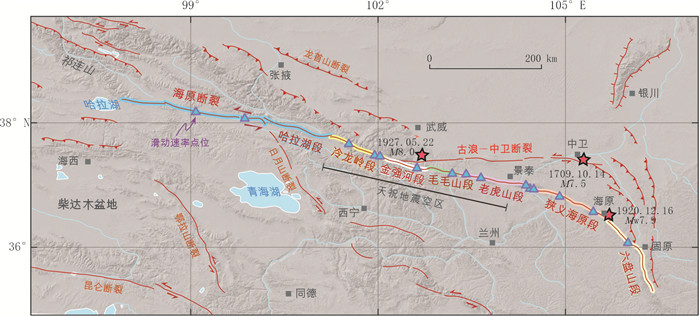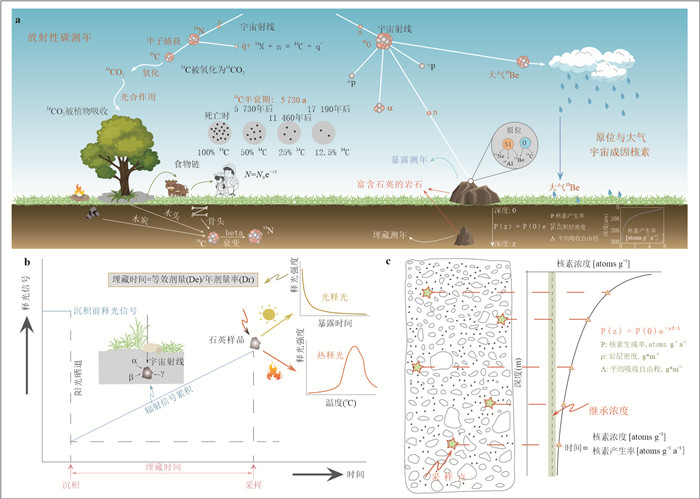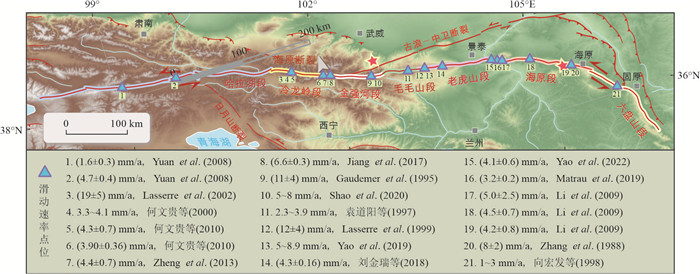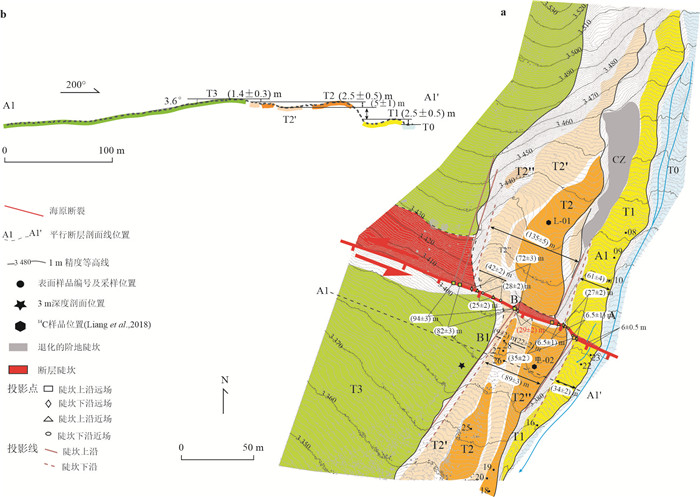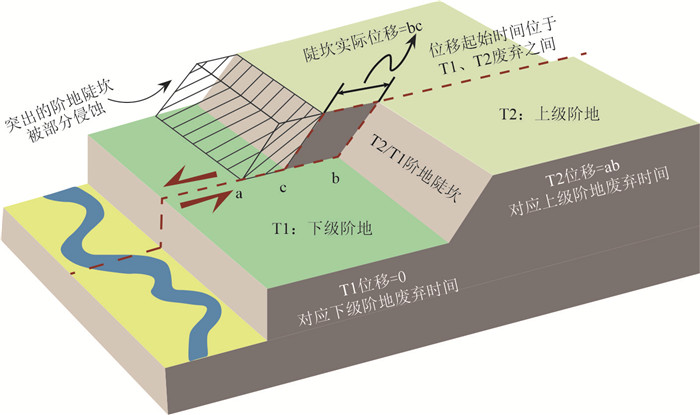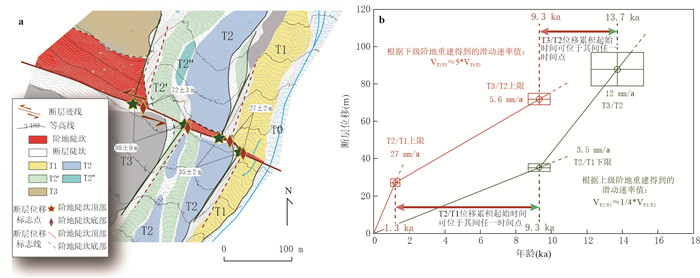Application of Tectonic Geomorphology Method for Constraining the Slip Rate Uncertainty and Implication of Strike-Slip Faults: An Example from the Haiyuan Fault Zone
-
摘要: 断层滑动速率是理解复杂断层系统应变分配与评估地震危险性的重要参数,在多种研究方法中,利用构造地貌学方法限定走滑断裂的第四纪滑动速率较为普遍. 在青藏高原活动断裂体系中,海原断裂带承载了部分印度-欧亚板块碰撞产生的应变,其滑动速率的精细厘定也是高原构造变形动力学分析的重要参数. 过去三十年间前人采用构造地貌学方法对其进行了大量的滑动速率研究,结果位于2.3~16 mm/a之间,不同研究间相差较大,因此引发了众多争议与困惑. 在对已有研究进行详细评述的基础上,指出前人研究结果不确定性的重要原因是上级阶地与下级阶地重建模型的选择. 结果认为,基于两种位移累积起始时间定义的模型得到的往往是滑动速率的上限或下限,不能简单地将其等同于滑动速率真实值. 当缺乏观测数据可以辅助判别两种模型的可靠程度时,应基于上、下级阶地废弃年龄同时对滑动速率进行限定,这是对滑动速率计算过程中客观存在的不确定性的尊重和认可. 海原断裂带滑动速率的评估将为后续基于青藏高原内部诸多活动断裂进行两种端元变形模型合理性的分析工作提供重要的方法借鉴.Abstract: The fault slip rate of is critical for understanding strain partitioning within a fault system and assessing seismic hazard. Tectonic geomorphology method can be used in constraining Quaternary slip rates in general. In the active fault system of Tibetan Plateau, the Haiyuan Fault Zone accommodates part of Indo-Asian convergence and its slip rate provides reference for understanding the mechanics of continental deformation. Thus, several slip rate studies have been carried out along the Haiyuan fault during the past 3 decades and the results range from 2.3 mm/a to 16 mm/a, which caused controversy and confusion. Based on a review of the previous studies, we point out that the main reason for the difference in previous studies is the choice of upper terrace and lower terrace reconstruction models. We infer that the upper and lower bound of slip rates are obtained based on the two models in general, which cannot be simply equated with the real slip rate value. When there is a lack of observational data to distinguish the reliability of the two models, a combination of upper and lower terrace abandonment age constraints can be used to bracket the slip rate. The method shows the respect and recognition of the objective uncertainty in the calculation process of slip rate. In addition, the evaluation of slip rates of Haiyuan fault zone can provide a basis for the identification of two end models of the Tibetan Plateau based on the intro-block faults deformation.
-
Key words:
- fault slip rates /
- Haiyuan fault /
- geomorphology /
- river terrace risers /
- the upper and lower bound
-
图 1 青藏高原东北缘主要活动断裂分布图
活动断裂修改自Tapponnier et al.(2001)
Fig. 1. Distribution of major active faults of the northeastern Tibetan Plateau region
表 1 海原断裂带滑动速率分布表
Table 1. Distribution of slip rates sites of the Haiyuan Fault
年份 分段 位置 纬度(°E) 位错测量信息 定年信息 滑动速率(mm/a) 评估 参考文献信息 位错特征 测量依据 位错测量值(m) 定年手段 阶段 具体年龄 1988 海原段 哨马营 105.35~105.67 冲沟、阶地陡坎 野外实地考察、地形图 20~114 14C 全新世 4 820~16 370 a 8±2 下切入阶地的河流开始位错的时间比阶地废弃时间年轻,本研究得到的阶地废弃年龄偏老,判断结果为滑动速率下限 Zhang et al.(1988a) 1991 海原段 西华山 105.3 地质体、岩性分界 构造地质填图野外实地考察 12.9~14.8 根据岩性年代估计 新生代 3~1.5 Ma 5~10 传统地质学方法 Burchfiel et al.(1991) 1995 金强河段 三个墩 102.69 最高级阶地 SPOT影像、经纬仪测量、野外实地考察 143+36/-24 根据区域与全球古气候评估 晚第四纪 (13.5±2) ka ~11 缺少角度定年手段,滑动速率结果存疑 Gaudemer et al.(1995) 1997 毛毛山段 毛毛山 102.95~103.43 多级阶地 野外实地考察 15~540 14C、热释光与标准黄土剖面 晚第四纪 7.2~236 ka 2.3~3.9 缺少阶地位移的具体描述,无法判断上下限 袁道阳等(1997) 1998 六盘山段 孙家庄 106 水系偏转 图面识别、野外实地考察 10~300 TL、主观估计 晚第四纪 (15.7±1.3)ka 1~3 位移与年代的对应关系为作者推断得到,且TL测年方法已经被滑动速率领域淘汰 向宏发等(1998) 1999 老虎山段 马家湾 103.49 阶地陡坎 高精度航拍影像、1m精度DEM、野外实地考察 125±10 14C 晚第四纪 (8 487±66)~(14 185±169)a 11.9±1.1 采用下阶地重建模型,结果滑动速率上限,但采集于阶地表面沉积层的样品年龄小于阶地废弃年龄,真实上限值可能低于(12±4)mm/a Lasserre et al.(1999) 宣马湾 103.47 阶地陡坎 80±11 14C 全新世 (7 624±43)a > 10.5±1.4 采用了下阶地重建模型,得到的速率值为该点位滑动速率上限 2000 冷龙岭段 宁缠丫豁 101.85 冲沟 野外考察、全站仪地形实测、室内遥感解译 125±20 热释光、土壤剖面 全新世 29.0 ka 3.2~4.3 TL定年手段已不适用于滑动速率研究 何文贵等(2000) 2002 冷龙岭段 宁缠丫豁 101.85 冰碛地貌 航空影像、SPOT影像、野外实地考察 200±40 宇宙成因核素 晚更新世 (10 300±339)a (11±3)~(19±5) 利用年龄上下限给出了冰碛山脊滑动速率上下限,结果基本可靠,但年龄结果未经矫正,可能导致滑动速率上限偏高 Lasserre et al.(2002) 2009 海原段 哨马营 105.37 冲沟位错 地形图、全站仪、野外实地考察 49±2 14C 全新世 (10 150±160)~(13 489±310)a 4.2±0.8 采用上级阶地模型与下级阶地模型同时限定滑动速率的方法,给出了滑动速率上下限,与本文主旨一致 Li et al.(2009) 高湾子 105.18 阶地陡坎 28~68 14C (7 070±100)~(13 440±300) a 4.5±0.7 荒凉滩 104.57 冲沟位错 22±2 14C (3 200±125)~(7 960±180) a 5.0±2.5 2010 冷龙岭段 宁缠丫豁 101.83 冰碛地貌 全站仪地形检测野外实地考察 125±20 TL 晚第四纪 (29.7±3.1)~(37.8±4.1) ka 3.3~4.2 信息模糊,难以进行滑动速率上下限评估 何文贵等(2010) 讨拉柴陇 101.96 阶地陡坎 50±5 14C (12 665±110) a 3.9±0.36 采用了下级阶地重建模型,在年龄与位错无误的情况下,该值为滑动速率上限 2013 冷龙岭段 讨拉柴陇 101.96 阶地陡坎 dGPS地形检测、野外实地考察 (26±4)~(35±3.5) 14C 全新世 (6 955±85) a 4.4±0.7 利用上下级阶地同时限定起使年龄的方式给出了滑动速率上下限,与本文主旨一致 Zheng et al.(2013) 2017 冷龙岭段 牛头 102.08 冲沟位错 LiDAR解译、卫星影像数据、野外实地考察 67.9±0.9 14C、OSL 晚第四纪 (10 300±339) a 6.6±0.3 采用了Lasserre等(2002)的定年结果,年龄与位错关系并不清晰 Jiang et al.(2017) 2018 老虎山段 老虎山 103.38~103.53 阶地陡坎 LiDAR DEM、野外实地考察 T1/T0:7~14;T2/T1:28~36;T3/T2:59~66;T4/T3: 180~190 14C、OSL 晚第四纪 T1-T4: 1~3 ka, 9~11 ka, 15~17 ka, 40~45 ka 4.3±0.16 采用上阶地废弃年龄作为阶地陡坎位错的起始年龄,利用蒙特卡洛算法进行迭代计算拟合得到最终的滑动速率值,为滑动速率下限 刘金瑞等(2018) 2019 老虎山段 哈斯山 104.42 阶地陡坎 高精度卫星影像野外实地考察 (~5)~(~200) TCNs 晚第四纪 (9±3)~(44±7) ka 3.2±0.2 采用下阶地重建模型,最终结果为该分支断裂的滑动速率上限 Matrau et al.(2019) 2019 老虎山段 马家湾 103.49 阶地陡坎 LiDAR DEM野外实地考察 (93±15)~(130±10) 14C、OSL、TCNs 晚第四纪 (9 867±164) a~(26.0±4.5) ka 5.0+1.5/-1.1~8.9+0.5/-1.3 采用上下级阶地同时限定位错起始时间的做法,与本文主旨相同,给出了滑动速率上下限 Yao et al.(2019) 宣马湾 103.47 68+3/-10 14C 全新世 (7 624±43) a 2021 金强河段 三个墩 102.69 阶地面、阶地陡坎 TLS点云数据、RTK-GPS地形剖面、航空正射影像数据、野外实地考察 (6.5±1)~(88±9) 14C、OSL、TCNs 晚第四纪 (9.3±0.6)~(13.7±1.5) ka 5~8 Shao et al.(2021) 2022 老虎山段 哈思山 140.33 阶地陡坎、冲沟 基于sUAV获取的高精度DEM、正射影像、野外考察 11.3+5/-4~22.4+6.8/-4.5 宇宙成因核素、OSL 晚第四纪 (9.3±2.9)~13.0+0.8/-0.2 ka 4.1±0.6 该值为叠加了Matrau et al(2019)滑动速率之后的结果,是滑动速率下限 Yao et al.(2022) -
Acharya, H. K., 1997. Influence of Fault Bends on Ruptures. Bulletin of the Seismological Society of America, 87(6): 1691-1696. https://doi.org/10.1785/bssa0870061691 Arrowsmith, J. R., Zielke, O., 2009. Tectonic Geomorphology of the San Andreas Fault Zone from High Resolution Topography: An Example from the Cholame Segment. Geomorphology, 113(1/2): 70-81. https://doi.org/10.1016/j.geomorph.2009.01.002 Avouac, J. P., Tapponnier, P., 1993. Kinematic Model of Active Deformation in Central Asia. Geophysical Research Letters, 20(10): 895-898. https://doi.org/10.1029/93gl00128 Bennett, R. A., Friedrich, A. M., Furlong, K. P., 2004. Codependent Histories of the San Andreas and San Jacinto Fault Zones from Inversion of Fault Displacement Rates. Geology, 32(11): 961. https://doi.org/10.1130/g20806.1 Bergen, K. J., Shaw, J. H., Leon, L. A., et al., 2017. Accelerating Slip Rates on the Puente Hills Blind Thrust Fault System beneath Metropolitan Los Angeles, California, USA. Geology, 45(3): 227-230. https://doi.org/10.1130/g38520.1 Berryman, K., 1990. Late Quaternary Movement on the Wellington Fault in the Upper Hutt Area, New Zealand. New Zealand Journal of Geology and Geophysics, 33(2): 257-270. https://doi.org/10.1080/00288306.1990.10425683 Biasi, G. P., Wesnousky, S. G., 2017. Bends and Ends of Surface Ruptures. Bulletin of the Seismological Society of America, 107(6): 2543-2560. https://doi.org/10.1785/0120160292 Bird, P., 2009. Long‐term Fault Slip Rates, Distributed Deformation Rates, and Forecast of Seismicity in the Western United States from Joint Fitting of Community Geologic, Geodetic, and Stress Direction Data Sets. Journal of Geophysical Research: Solid Earth, 114(B11): 403. https://doi.org/10.1029/2009jb006317 Blisniuk, K., Oskin, M., Mériaux, A. S., et al., 2013. Stable, Rapid Rate of Slip since Inception of the San Jacinto Fault, California. Geophysical Research Letters, 40(16): 4209-4213. https://doi.org/10.1002/grl.50819 Burchfiel, B. C., Zhang, P. Z., Wang, Y. P., et al., 1991. Geology of the Haiyuan Fault Zone, Ningxia‐Hui Autonomous Region, China, and its Relation to the Evolution of the Northeastern Margin of the Tibetan Plateau. Tectonics, 10(6): 1091-1110. https://doi.org/10.1029/90tc02685 Burgette, R. J., Hanson, A. M., Scharer, K. M., et al., 2020. Late Quaternary Slip Rate of the Central Sierra Madre Fault, Southern California: Implications for Slip Partitioning and Earthquake Hazard. Earth and Planetary Science Letters, 530(1): 115907. https://doi.org/10.1016/j.epsl.2019.115907 Carne, R., Little, T., Rieser, U., 2011. Using Displaced River Terraces to Determine Late Quaternary Slip Rate for the Central Wairarapa Fault at Waiohine River, New Zealand. New Zealand Journal of Geology and Geophysics, 54(2): 217-236. https://doi.org/10.1080/00288306.2010.532224 Cavalié, O., Lasserre, C., Doin, M. P., et al., 2008. Measurement of Interseismic Strain Across the Haiyuan Fault (Gansu, China), by InSAR. Earth and Planetary Science Letters, 275(3/4): 246-257. https://doi.org/10.1016/j.epsl.2008.07.057 Chen, T., Liu, Z. J., Shao, Y. X., et al., 2018. Geomorphic Offsets along the Creeping Laohu Shan Section of the Haiyuan Fault, Northern Tibetan Plateau. Geosphere, 14(3): 1165-1186. https://doi.org/10.1130/GES01561.1 Chen, T., Zhang, P. Z., Liu, J., et al., 2014. Quantitative Study of Tectonic Geomorphology along Haiyuan Fault Based on Airborne LiDAR. Chinese Science Bulletin, 59(20): 2396-2409. https://doi.org/10.1007/s11434-014-0199-4 Chéry, J., Vernant, P., 2006. Lithospheric Elasticity Promotes Episodic Fault Activity. Earth and Planetary Science Letters, 243(1/2): 211-217. https://doi.org/10.1016/j.epsl.2005.12.014 Chevalier, M. L., Leloup, P. H., Replumaz, A., et al., 2016. Tectonic-Geomorphology of the Litang Fault System, SE Tibetan Plateau, and Implication for Regional Seismic Hazard. Tectonophysics, 682(5): 278-292. https://doi.org/10.1016/j.tecto.2016.05.039 Chevalier, M. L., Ryerson, F. J., Tapponnier, P., et al., 2005. Response to Comment on "Slip-Rate Measurements on the Karakorum Fault may Imply Secular Variations in Fault Motion". Science, 309(5739): 1326-1326. https://doi.org/10.1126/science.1112629 Cowgill, E., 2007. Impact of Riser Reconstructions on Estimation of Secular Variation in Rates of Strike-Slip Faulting: Revisiting the Cherchen River Site along the Altyn Tagh Fault, NW China. Earth and Planetary Science Letters, 254(3/4): 239-255. https://doi.org/10.1016/j.epsl.2006.09.015 Cowgill, E., Gold, R. D., Chen, X. H., et al., 2009. Low Quaternary Slip Rate Reconciles Geodetic and Geologic Rates along the Altyn Tagh Fault, Northwestern Tibet. Geology, 37(7): 647-650. https://doi.org/10.1130/g25623a.1 Dair, L., Cooke, M. L., 2009. San Andreas Fault Geometry through the San Gorgonio Pass, California. Geology, 37(2): 119-122. https://doi.org/10.1130/g25101a.1 Daout, S., Jolivet, R., Lasserre, C., et al., 2016. Along-Strike Variations of the Partitioning of Convergence Across the Haiyuan Fault System Detected by InSAR. Geophysical Journal International, 205(1): 536-547. https://doi.org/10.1093/gji/ggw028 Deng, Q. D., 2011. Learning and Progress through Scientific Practices: Commemorating the 90th Anniversary of the Tragic Haiyuan Earthquake, Striving to Advance Our Abilities of Earthquake Prediction and Seismic Hazard Reduction. Seismology and Geology, 33(1): 1-14 (in Chinese with English abstract). doi: 10.3969/j.issn.0253-4967.2011.01.001 Deng, Q. D., Sung, F., Zhu, S. L., et al., 1984. Active Faulting and Tectonics of the Ningxia‐Hui Autonomous Region, China. Journal of Geophysical Research: Solid Earth, 89(B6): 4427-4445. https://doi.org/10.1029/jb089ib06p04427 England, P., Houseman, G., 1986. Finite Strain Calculations of Continental Deformation: 2. Comparison with the India‐Asia Collision Zone. Journal of Geophysical Research: Solid Earth, 91(B3): 3664-3676. https://doi.org/10.1029/jb091ib03p03664 England, P., Molnar, P., 2005. Late Quaternary to Decadal Velocity Fields in Asia. Journal of Geophysical Research: Solid Earth, 110(B12): 401. https://doi.org/10.1029/2004jb003541 Field, E. H., Arrowsmith, R. J., Biasi, G. P., et al., 2014. Uniform California Earthquake Rupture Forecast, Version 3 (UCERF3): The Time-Independent Model. Bulletin of the Seismological Society of America, 104(3): 1122-1180. https://doi.org/10.1785/0120130164 Frankel, K. L., Dolan, J. F., Finkel, R. C., et al., 2007. Spatial Variations in Slip Rate along the Death Valley‐Fish Lake Valley Fault System Determined from LiDAR Topographic Data and Cosmogenic 10Be Geochronology. Geophysical Research Letters, 34(18): L18303. https://doi.org/10.1029/2007gl030549 Friedrich, A. M., Wernicke, B. P., Niemi, N. A., et al., 2003. Comparison of Geodetic and Geologic Data from the Wasatch Region, Utah, and Implications for the Spectral Character of Earth Deformation at Periods of 10 to 10 Million Years. Journal of Geophysical Research: Solid Earth, 108(B4): 2199. https://doi.org/10.1029/2001jb000682 Gan, W. J., Zhang, P. Z., Shen, Z. K., et al., 2007. Present-Day Crustal Motion within the Tibetan Plateau Inferred from GPS Measurements. Journal of Geophysical Research: Solid Earth, 112(B8): B08416. https://doi.org/10.1029/2005JB004120 Gasse, F., Arnold, M., Fontes, J. C., et al., 1991. A 13, 000-Year Climate Record from Western Tibet. Nature, 353(6346): 742-745. https://doi.org/10.1038/353742a0 Gaudemer, Y., Tapponnier, P., Meyer, B., et al., 1995. Partitioning of Crustal Slip between Linked, Active Faults in the Eastern Qilian Shan, and Evidence for a Major Seismic Gap, the 'Tianzhu Gap', on the Western Haiyuan Fault, Gansu (China). Geophysical Journal International, 120(3): 599-645. https://doi.org/10.1111/j.1365-246X.1995.tb01842.x Gold, R. D., Cowgill, E., 2011. Deriving Fault-Slip Histories to Test for Secular Variation in Slip, with Examples from the Kunlun and Awatere Faults. Earth and Planetary Science Letters, 301(1-2): 52-64. https://doi.org/10.1016/j.epsl.2010.10.01 Gold, R. D., Cowgill, E., Arrowsmith, J. R., et al., 2009. Riser Diachroneity, Lateral Erosion, and Uncertainty in Rates of Strike‐Slip Faulting: A Case Study from Tuzidun along the Altyn Tagh Fault, NW China. Journal of Geophysical Research: Solid Earth, 114(B4): B04401. https://doi.org/10.1029/2008jb005913 Gold, R. D., Friedrich, A., Kübler, S., et al., 2017. Apparent Late Quaternary Fault‐Slip Rate Increase in the Southern Lower Rhine Graben, Central Europe. Bulletin of the Seismological Society of America, 107(2): 563-580. https://doi.org/10.1785/0120160197 Goren, L., Castelltort, S., Klinger, Y., 2015. Modes and Rates of Horizontal Deformation from Rotated River Basins: Application to the Dead Sea Fault System in Lebanon. Geology, 43(9): 843-846. https://doi.org/10.1130/g36841.1 Han, L. F., Jing, L. Z., Yao, W. Q., et al., 2021. Coseismic Slip Gradient at the Western Terminus of the 1920 Haiyuan Mw 7.9 Earthquake. Journal of Structural Geology, 152(1): 104442. https://doi.org/10.1016/j.jsg.2021.104442 Hancock, G. S., Anderson, R. S., 2002. Numerical Modeling of Fluvial Strath-Terrace Formation in Response to Oscillating Climate. GSA Bulletin, 114(9): 1131-1142. https://doi.org/10.1130/0016-7606(2002)114<1131:nmofst>2.0.co;2 doi: 10.1130/0016-7606(2002)114<1131:nmofst>2.0.co;2 Hanks, T. C., Schwartz, D. P., 1987. Morphologic Dating of the Pre-1983 Fault Scarp on the Lost River Fault at Doublespring Pass Road, Custer County, Idaho. Bulletin of the Seismological Society of America, 77(3): 837-846. https://doi.org/10.1785/BSSA0770030837 Harkins, N., Kirby, E., 2008. Fluvial Terrace Riser Degradation and Determination of Slip Rates on Strike-Slip Faults: An Example from the Kunlun Fault, China. Geophysical Research Letters, 35(5): L05406. https://doi.org/10.1029/2007gl033073 He, W. G., Liu, B. H., Yuan, D. Y., et al., 2000. Research on Slip Rates of the Lenglongling Active Fault Zone. Northwestern Seismological Journal, 22(1): 90-97 (in Chinese with English abstract). He, W. G., Yuan, D. Y., Ge, W. P., et al., 2010. Determination of the Slip Rate of the Lenglongling Fault in the Middle and Eastern Segments of the Qilian Mountain Active Fault Zone. Earthquake, 30(1): 131-137 (in Chinese with English abstract). doi: 10.3969/j.issn.1000-3274.2010.01.015 Hetzel, R., Niedermann, S., Tao, M. X., et al., 2002. Low Slip Rates and Long-Term Preservation of Geomorphic Features in Central Asia. Nature, 417(6887): 428-432. https://doi.org/10.1038/417428a Hetzel, R., Tao, M. X., Stokes, S., et al., 2004. Late Pleistocene/Holocene Slip Rate of the Zhangye Thrust (Qilian Shan, China) and Implications for the Active Growth of the Northeastern Tibetan Plateau. Tectonics, 23(6): TC6006. https://doi.org/10.1029/2004TC00165 Hoeft, J. S., Frankel, K. L., 2010. Temporal Variations in Extension Rate on the Lone Mountain Fault and Strain Distribution in the Eastern California Shear Zone-Walker Lane. Geosphere, 6(6): 917-936. https://doi.org/10.1130/ges00603.1 Huang, Z. C., Zhou, Y., Qiao, X., et al., 2022. Kinematics of the ∼1 000 Km Haiyuan Fault System in Northeastern Tibet from High-Resolution Sentinel-1 InSAR Velocities: Fault Architecture, Slip Rates, and Partitioning. Earth and Planetary Science Letters, 583(6773): 117450. https://doi.org/10.1016/j.epsl.2022.117450 Hudnut, K. W., Borsa, A., Glennie, C., et al., 2002. High-Resolution Topography along Surface Rupture of the 16 October 1999 Hector Mine, California, Earthquake (Mw 7. 1) from Airborne Laser Swath Mapping. Bulletin of the Seismological Society of America, 92(4): 1570-1576. https://doi.org/10.1785/0120000934 Institute of Geology, China Earthquake Administration, Earthquake Administration of Ningxia Hui Autonomous Region, 1990. Active Haiyuan Fault Zone. Seismological Press, Beijing (in Chinese). Jiang, W. L., Han, Z. J., Guo, P., et al., 2017. Slip Rate and Recurrence Intervals of the East Lenglongling Fault Constrained by Morphotectonics: Tectonic Implications for the Northeastern Tibetan Plateau. Lithosphere, 9(3): 417-430. https://doi.org/10.1130/l597.1 Jing, L. Z., Klinger, Y., Xu, X., et al., 2007. Millennial Recurrence of Large Earthquakes on the Haiyuan Fault near Songshan, Gansu Province, China. Bulletin of the Seismological Society of America, 97(1B): 14-34. https://doi.org/10.1785/0120050118 Jing, L. Z., Shao, Y. X., Klinger, Y., et al., 2015. Variability in Magnitude of Paleoearthquakes Revealed by Trenching and Historical Records, along the Haiyuan Fault, China. Journal of Geophysical Research: Solid Earth, 120(12): 8304-8333. https://doi.org/10.1002/2015jb012163 Jing, L. Z., Chen, T., Zhang, P. Z., et al., 2013. Illuminating the Active Haiyuan Fault, China by Airborne Light Detection and Ranging. Chinese Science Bulletin, 58(1): 41-45 (in Chinese with English abstract). doi: 10.1360/972012-1526 Jolivet, R., Lasserre, C., Doin, M. P., et al., 2013. Spatio-Temporal Evolution of Aseismic Slip along the Haiyuan Fault, China: Implications for Fault Frictional Properties. Earth and Planetary Science Letters, 377-378(2-3): 23-33. https://doi.org/10.1016/j.epsl.2013.07.020 King, G., 1986. Speculations on the Geometry of the Initiation and Termination Processes of Earthquake Rupture and Its Relation to Morphology and Geological Structure. Geophysical Research Letters, 124(3): 567-585. https://doi.org/10.1007/BF00877216 King, G., Nábělek, J., 1985. Role of Fault Bends in the Initiation and Termination of Earthquake Rupture. Science (New York, N. Y. ), 228(4702): 984-987. https://doi.org/10.1126/science.228.4702.984 Kirby, E., Harkins, N., Wang, E. Q., et al., 2007. Slip Rate Gradients along the Eastern Kunlun Fault. Tectonics, 26(2): TC2010. https://doi.org/10.1029/2006TC002033 Klinger, Y., 2010. Relation between Continental Strike-Slip Earthquake Segmentation and Thickness of the Crust. Journal of Geophysical Research: Solid Earth, 115: B07306. https://doi.org/10.1029/2009JB006550 Klinger, Y., Etchebes, M., Tapponnier, P., et al., 2011. Characteristic Slip for Five Great Earthquakes along the Fuyun Fault in China. Nature Geoscience, 4(6): 389-392. https://doi.org/10.1038/ngeo1158 Knuepfer, P. L. K., 1992. Temporal Variations in Latest Quaternary Slip Across the Australian‐Pacific Plate Boundary, Northeastern South Island, New Zealand. Tectonics, 11(3): 449-464. https://doi.org/10.1029/91tc02890 Koehler, R. D., 2019. Active Faulting in the North Valleys Region of Reno, Nevada: A Distributed Zone within the Northern Walker Lane. Geomorphology, 326(5): 38-53. https://doi.org/10.1016/j.geomorph.2018.09.015 Küster, Y., Hetzel, R., Krbetschek, M., et al., 2006. Holocene Loess Sedimentation along the Qilian Shan (China): Significance for Understanding the Processes and Timing of Loess Deposition. Quaternary Science Reviews, 25(1/2): 114-125. https://doi.org/10.1016/j.quascirev.2005.03.003 Lague, D., Hovius, N., Davy, P., 2005. Discharge, Discharge Variability, and the Bedrock Channel Profile. Journal of Geophysical Research: Earth Surface, 110(F4): F04006. https://doi.org/10.1029/2004JF000259 Lai, Z. P., Ou, X. J., 2013. Basic Procedures of Optically Stimulated Luminescence (OSL) Dating. Progress in Geography, 32(5): 683-693 (in Chinese with English abstract). Lasserre, C., Gaudemer, Y., Tapponnier, P., et al., 2002. Fast Late Pleistocene Slip Rate on the Leng Long Ling Segment of the Haiyuan Fault, Qinghai, China. Journal of Geophysical Research: Solid Earth, 107(B11): 2276. https://doi.org/10.1029/2000JB000060 Lasserre, C., Morel, P. H., Gaudemer, Y., et al., 1999. Postglacial Left Slip Rate and Past Occurrence of M≥8 Earthquakes on the Western Haiyuan fault, Gansu, China. Journal of Geophysical Research: Solid Earth, 104(B8): 17633-17651. https://doi.org/10.1029/1998JB900082 Lensen, G. J., 1968. Analysis of Progressive Fault Displacement during Downcutting at the Branch River Terraces, South Island, New Zealand. Geological Society of America Bulletin, 79(5): 545. https://doi.org/10.1130/0016-7606(1968)79[545:aopfdd]2.0.co;2 Li, C. Y., Zhang, P. Z., Yin, J. H., et al., 2009. Late Quaternary Left-Lateral Slip Rate of the Haiyuan Fault, Northeastern Margin of the Tibetan Plateau. Tectonics, 28: TC5010. https://doi.org/10.1029/2008TC002302 Li, H., Yu, Z. D., Cai, X. B., et al., 2013. River Terrace Extraction Based on Unmanned Aerial Vehicle Remote Sensing. Earth Science, 42(5): 734-742 (in Chinese with English abstract). Li, Y. C., Nocquet, J. M., Shan, X. J., et al., 2021. Geodetic Observations of Shallow Creep on the Laohushan-Haiyuan Fault, Northeastern Tibet. Journal of Geophysical Research: Solid Earth, 126(6). https://doi.org/10.1029/2020JB021576 Li, Y. C., Shan, X. J., Qu, C. Y., et al., 2018. Crustal Deformation of the Altyn Tagh Fault based on GPS. Journal of Geophysical Research: Solid Earth, 123(11): 10309-10322. https://doi.org/10.1029/2018JB015814 Li, Y. H., Cui, D. X., Hao, M., 2015. GPS-Constrained Inversion of Slip Rate on Major Active Faults in the Northeastern Margin of Tibet Plateau. Earth Science, 40(10): 1767-1780 (in Chinese with English abstract). Liu, B. H., Zhang, J. L., Wu, J. H., et al., 2003. Reevaluating on Casualty in the Haiyuan Ms 8.5 Earthquake on December 16, 1920. Earthquake Research in China, 19(4): 386-399. Liu, J. R., Ren, Z. K., Zhang, H. P., et al., 2018. Late Quaternary Slip Rate of the Laohushan Fault within the Haiyuan Fault Zone and Its Tectonic Implications. Chinese Journal of Geophysics, 61(004): 1281-1297 (in Chinese with English abstract). Ma, H. C., 2011. Review on Applications of LiDAR Mapping Technology to Geosciences. Earth Science, 36(2): 347-354 (in Chinese with English abstract). Malatesta, L. C., Avouac, J. P., Brown, N. D., et al., 2018. Lag and Mixing during Sediment Transfer across the Tian Shan Piedmont Caused by Climate-Driven Aggradation-Incision Cycles. Basin Research, 30(4): 613-635. https://doi.org/10.1111/bre.12267 Matrau, R., Klinger, Y., Van der Woerd, J., et al., 2019. Late Pleistocene-Holocene Slip Rate along the Hasi Shan Restraining Bend of the Haiyuan Fault: Implication for Faulting Dynamics of a Complex Fault System. Tectonics, 38(12): 4127-4154. https://doi.org/10.1029/2019TC005488 McGill, S. F., Rubin, C. M., 1999. Surficial Slip Distribution on the Central Emerson Fault during the June 28, 1992, Landers Earthquake, California. Journal of Geophysical Research: Solid Earth, 104(B3): 4811-4833. https://doi.org/10.1029/98jb01556 McGill, S. F., Sieh, K., 1991. Surficial Offsets on the Central and Eastern Garlock Fault Associated with Prehistoric Earthquakes. Journal of Geophysical Research: Solid Earth, 96(B13): 21597-21621. https://doi.org/10.1029/91jb02030 Mériaux, A. S., Ryerson, F. J., Tapponnier, P., et al., 2004. Rapid Slip along the Central Altyn Tagh Fault: Morphochronologic Evidence from Cherchen He and Sulamu Tagh. Journal of Geophysical Research: Solid Earth, 109(B6): B06401. https://doi.org/10.1029/2003JB002558 Mériaux, A. S., Tapponnier, P., Ryerson, F. J., et al., 2005. The Aksay Segment of the Northern Altyn Tagh Fault: Tectonic Geomorphology, Landscape Evolution, and Holocene Slip Rate. Journal of Geophysical Research: Solid Earth, 110(B4): B04404. https://doi.org/10.1029/2004JB003210 Mériaux, A. S., Van der Woerd, J., Tapponnier, P., et al., 2012. The Pingding Segment of the Altyn Tagh Fault (91°E): Holocene Slip-Rate Determination from Cosmogenic Radionuclide Dating of Offset Fluvial Terraces. Journal of Geophysical Research: Solid Earth, 117(B9). https://doi.org/10.1029/2012JB009289 Meyer, B., Tapponnier, P., Bourjot, L., et al., 1998. Crustal Thickening in Gansu-Qinghai, Lithospheric Mantle Subduction, and Oblique, Strike-Slip Controlled Growth of the Tibet Plateau. Geophysical Journal International, 135(1), 1-47. https://doi.org/10.1046/j.1365-246X.1998.00567.x Meyer, B., Tapponnier, P., Gaudemer, Y., et al., 1996. Rate of Left-Lateral Movement along the Easternmost Segment of the Altyn Tagh Fault, East of 96°E (China). Geophysical Journal International, 124(1): 29-44. https://doi.org/10.1111/j.1365-246x.1996.tb06350.x Middleton, T. A., Walker, R. T., Parsons, B., et al., 2016. A Major, Intraplate, Normal‐faulting Earthquake: The 1739 Yinchuan Event in Northern China. Journal of Geophysical Research: Solid Earth, 121(1): 293-320. https://doi.org/10.1002/2015jb012355 Molnar, P., Tapponnier, P., 1975. Cenozoic Tectonics of Asia: Effects of a Continental Collision. Science, 189(4201): 419-426. https://doi.org/10.1126/science.189.4201.419 Oskin, M., Perg, L., Blumentritt, D., et al., 2007. A Slip Rate of the Calico Fault: Implications for Geologic versus Geodetic Rate Discrepancy in the Eastern California Shear Zone. Journal of Geophysical Research: Solid Earth, 112(B7): B03402. https://doi.org/10.1029/2006JB004451 Ou, Q., Kulikova, G., Yu, J., et al., 2020. Magnitude of the 1920 Haiyuan Earthquake Reestimated Using Seismological and Geomorphological Methods. Journal of Geophysical Research: Solid Earth, 125(8). https://doi.org/10.1029/2019JB019244 Peltzer, G., Saucier, F., 1996. Present‐day Kinematics of Asia Derived from Geologic Fault Rates. Journal of Geophysical Research: Solid Earth, 101(B12): 27943-27956. https://doi.org/10.1029/96jb02698 Peltzer, G., Tapponnier, P., Armijo, R., 1989. Magnitude of Late Quaternary Left-Lateral Displacements along the North Edge of Tibet. Science, 246(4935): 1285-1289. https://doi.org/10.1126/science.246.4935.1285 Peltzer, G., Brown, N. D., Meriaux, A. S., et al., 2020. Stable Rate of Slip along the Karakax Section of the Altyn Tagh Fault from Observation of Interglacial and Postglacial Offset Morphology and Surface Dating. Journal of Geophysical Research: Solid Earth, 125 (5). https://doi.org/10.1029/2019JB018893 Poisson, B., Avouac, J. P., 2004. Holocene Hydrological Changes Inferred from Alluvial Stream Entrenchment in North Tian Shan (Northwestern China). The Journal of Geology, 112(2): 231-249. https://doi.org/10.1086/381659 Prush, V. B., Oskin, M. E., 2020. A Mechanistic Erosion Model for Cosmogenic Nuclide Inheritance in Single-Clast Exposure Ages. Earth and Planetary Science Letters, 535(268): 116066. https://doi.org/10.1016/j.epsl.2020.116066 Ran, Y. K., Duan, R. T., Deng, Q. D., et al., 1997. 3D Trench Excavation and Paleoseismology at Gaowanzi of the Haiyuan Fault. Seismology and Geology, 19(2): 97-107 (in Chinese with English abstract). Ren, Z. K., Zhang, Z. Q., Chen, T., et al., 2016. Clustering of Offsets on the Haiyuan Fault and Their Relationship to Paleoearthquakes. Geological Society of America Bulletin, 128(1-2): 3-18. https://doi.org/10.1130/B31155.1 Rockwell, T. K., Keller, E. A., Clark, M. N., et al., 1984. Chronology and Rates of Faulting of Ventura River Terraces, California. Geological Society of America Bulletin, 95(12): 1466. https://doi.org/10.1130/0016-7606(1984)95<1466:carofo>2.0.co;2 doi: 10.1130/0016-7606(1984)95<1466:carofo>2.0.co;2 Rollins, C., Avouac, J. P., Landry, W., et al., 2018. Interseismic Strain Accumulation on Faults beneath Los Angeles, California. Journal of Geophysical Research: Solid Earth, 123(8): 7126-7150. https://doi.org/10.1029/2017JB015387 Rood, D. H., Burbank, D. W., Finkel, R. C., 2011. Spatiotemporal Patterns of Fault Slip Rates Across the Central Sierra Nevada Frontal Fault Zone. Earth and Planetary Science Letters, 301(3/4): 457-468. https://doi.org/10.1016/j.epsl.2010.11.006 Scharer, K. M., Biasi, G. P., Weldon, R. J., 2011. A Reevaluation of the Pallett Creek Earthquake Chronology Based on New AMS Radiocarbon Dates, San Andreas Fault, California. Journal of Geophysical Research: Solid Earth, 116: B12111. https://doi.org/10.1029/2010JB008099 Scharer, K. M., Weldon, R. J., Fumal, T. E., et al., 2007. Paleoearthquakes on the Southern San Andreas Fault, Wrightwood, California, 3000 to 1500 B. C. : A New Method for Evaluating Paleoseismic Evidence and Earthquake Horizons. Bulletin of the Seismological Society of America, 97(4): 1054-1093. https://doi.org/10.1785/0120060137 Shao, Y. X., Jing, L. Z., Van Der Woerd, J., et al., 2021. Late Pleistocene Slip Rate of the Central Haiyuan Fault Constrained from Optically Stimulated Luminescence, 14C, and Cosmogenic Isotope Dating and High-Resolution Topography. Geological Society of America Bulletin, 133(7-8): 1347-1369. https://doi.org/10.1130/B35571.1 Sieh, K. E., Jahns, R. H., 1984. Holocene Activity of the San Andreas Fault at Wallace Creek, California. Geological Society of America Bulletin, 95(8): 883-896. https://doi.org/10.1130/0016-7606(1984)95<883:HAOTSA>2.0.CO;2 doi: 10.1130/0016-7606(1984)95<883:HAOTSA>2.0.CO;2 Tapponnier, P., Molnar, P., 1976. Slip-Line Field Theory and Large-Scale Continental Tectonics. Nature, 264(5584): 319-324. https://doi.org/10.1038/264319a0 Tapponnier, P., Molnar, P., 1977. Active Faulting and Tectonics in China. Journal of Geophysical Research, 82(20): 2905-2930. https://doi.org/10.1029/jb082i020p02905 Tapponnier, P., Xu, Z. Q., Roger, F., et al., 2001. Oblique Stepwise Rise and Growth of the Tibet Plateau. Science, 294(5547): 1671-1677. https://doi.org/10.1126/science.105978 Thompson, S. C., Weldon, R. J., Charles, M., et al., 2002. Late Quaternary Slip Rates across the Central Tien Shan, Kyrgyzstan, Central Asia. Journal of Geophysical Research: Solid Earth, 107(B9): ETG 7-1-ETG 7-32. https://doi.org/10.1029/2001JB000596 Van Der Woerd, J, Ryerson, F. J., Tapponnier, P., et al., 1998. Holocene Left-Slip Rate Determined by Cosmogenic Surface Dating on the Xidatan Segment of the Kunlun Fault (Qinghai, China). Geology, 26(8): 695-698. https://doi.org/10.1130/0091-7613(1998)026<0695:HLSRDB>2.3.CO;2 doi: 10.1130/0091-7613(1998)026<0695:HLSRDB>2.3.CO;2 Van Der Woerd, J., Tapponnier, P., Ryerson, F. J., et al., 2002. Uniform Postglacial Slip-Rate along the Central 600 km of the Kunlun Fault (Tibet), from 26Al, 10Be, and 14C Dating of Riser Offsets, and Climatic Origin of the Regional Morphology. Geophysical Journal International, 148(3): 356-388. https://doi.org/10.1046/j.1365-246x.2002.01556.x Van Der Woerd, J., Klinger, Y., Sieh, K., et al., 2006. Long-Term Slip Rate of the Southern San Andreas Fault from 10Be-26Al Surface Exposure Dating of an Offset Alluvial Fan. Journal of Geophysical Research: Solid Earth, 111(B4). https://doi.org/10.1029/2004JB003559 Wang, W., Qiao, X. J., Yang, S. M., et al., 2017. Present-Day Velocity Field and Block Kinematics of Tibetan Plateau from GPS Measurements. Geophysical Journal International, 208(2): 1088-1102. https://doi.org/10.1093/gji/ggw445 Weldon, R. J., Fumal, T. E., Biasi, G. P., et al., 2005. Past and Future Earthquakes on the San Andreas Fault. Science, 308(5724): 966-967. https://doi.org/10.1126/science.1111707 Weldon, R. J., Sieh, K. E., 1985. Holocene Rate of Slip and Tentative Recurrence Interval for Large Earthquakes on the San Andreas Fault, Cajon Pass, Southern California. Geological Society of America Bulletin, 96(6): 793. https://doi.org/10.1130/0016-7606(1985)96<793:hrosat>2.0.co;2 doi: 10.1130/0016-7606(1985)96<793:hrosat>2.0.co;2 Wells, R. E., Blakely, R. J., Bemis, S., 2020. Northward Migration of the Oregon Forearc on the Gales Creek Fault. Geosphere, 16(2): 660-684. https://doi.org/10.1130/ges02177.1 Weng, W. H., 1922. The 1920-12-16 Earthquake in Gansu Province. Science, 7: 105-144 (in Chinese). Wesnousky, S. G., 2006. Predicting the Endpoints of Earthquake Ruptures. Nature, 444(7117): 358-360. https://doi.org/10.1038/nature05275 Xiang, H. F., Guo, S. M., Zhang, B. L., et al., 1988. Active Features of the Eastern Liupanshan Piedmont Reverse Fault Zone since Late Qurternary. Seismology and Geology, 20(4): 312-327 (in Chinese with English abstract). Yang, H. B., Yang, X. P., Cunningham, D., et al., 2020. A Regionally Evolving Transpressional Duplex along the Northern Margin of the Altyn Tagh Fault: New Kinematic and Timing Constraints from the Sanweishan and Nanjieshan, China. Tectonics, 39(2). https://doi.org/10.1029/2019TC005749 Yao, W. Q., Liu-Zeng, J., Klinger, Y., et al., 2022. Late Quaternary Slip Rate of the Zihong Shan Branch and ItsImplications for Strain Partitioning Along the Haiyuan Fault, Northeastern Tibetan Plateau. Journal of Geophysical Research: Solid Earth, 127(5). https://doi.org/10.1029/2021JB023162 Yao, W. Q., Liu-Zeng, J., Oskin, M. E., et al., 2019. Reevaluation of the Late Pleistocene Slip Rate of the Haiyuan Fault Near Songshan, Gansu Province, China. Journal of Geophysical Research: Solid Earth, 124(5): 5217-5240. https://doi.org/10.1029/2018JB016907 Yin, A., Rumelhart, P. E., Butler, R., et al., 2002. Tectonic History of the Altyn Tagh Fault System in Northern Tibet Inferred from Cenozoic Sedimentation. Geological Society of America Bulletin, 114(10): 1257-1295. https://doi.org/10.1130/0016-7606(2002)114<1257:thotat>2.0.co;2 doi: 10.1130/0016-7606(2002)114<1257:thotat>2.0.co;2 Yuan, D. Y., Liu, B. H., Lv, T. Y., et al., 1997. Slip Rates of the Maomaoshan Fault Zone in Gansu Province Obtainted by Using Ages of Loess Palaeosoil Sequence. Seismology and Geology, 19(1): 1-8 (in Chinese with English abstract). Yuan, D. Y., Liu, B. H., Lv, T. Y., et al., 1998. Study on the Segmentation in East Segment of the Northern Qilianshan Fault Zone. Northwestern Seismological Journal, 20(4): 27-34 (in Chinese with English abstract). Yuan, D. Y., Zhang, P. Z., Ge, W. P., et al., 2008. Late Quaternary Strike-Slip Features along the Western Segment of Haiyuan-Qilianshan Fault. In: NE Tibetan Plateau. American Geophysical Union Fall Meeting, San Francisco. Yue, Y. J., Ritts, B. D., Graham, S. A., 2001. Initiation and Long-Term Slip History of the Altyn Tagh Fault. International Geology Review, 43(12): 1087-1093. https://doi.org/10.1080/00206810109465062 Zhang, P. Z., Deng, Q. D., Zhang, G. M., et al., 2003. Active Tectonic Blocks and Strong Earthquakes in the Continent of China. Science in China Series D Earth Sciences, 46(S2): 13-24. https://doi.org/10.1360/03dz0002 Zhang, P. Z., Molnar, P., Burchfiel, B. C., et al., 1988a. Bounds on the Holocene Slip Rate of the Haiyuan Fault, North-Central China. Quaternary Research, 30(2): 151-164. https://doi.org/10.1016/0033-5894(88)90020-8 Zhang, P. Z., Molnar, P., Xu, X. W., 2007. Late Quaternary and Present-Day Rates of Slip along the Altyn Tagh Fault, Northern Margin of the Tibetan Plateau. Tectonics, 26(5). https://doi.org/10.1029/2006TC002014 Zhang, P. Z., Molnar, P., Zhang, W. Q., et al., 1988b. Bounds on the Average Recurrence Interval of Major Earthquakes along the Haiyuan Fault in North-Central China. Seismological Research Letters, 59: 81-89. https://doi.org/10.1785/gssrl.59.3.81 Zheng, D. W., Zhang, P. Z., Wan, J. L., et al., 2006. Rapid Exhumation at ~8 Ma on the Liupan Shan Thrust Fault from Apatite Fission-Track Thermochronology: Implications for Growth of the Northeastern Tibetan Plateau Margin. Earth and Planetary Science Letters, 248(1/2): 198-208. https://doi.org/10.1016/j.epsl.2006.05.023 Zheng, W. J., Zhang, P. Z., He, W. G., et al., 2013. Transformation of Displacement between Strike-Slip and Crustal Shortening in the Northern Margin of the Tibetan Plateau: Evidence from Decadal GPS Measurements and Late Quaternary Slip Rates on Faults. Tectonophysics, 584(B7): 267-280. https://doi.org/10.1016/j.tecto.2012.01.006 Zielke, O., Arrowsmith, J. R., Ludwig, L. G., et al., 2010. Slip in the 1857 and Earlier Large Earthquakes along the Carrizo Plain, San Andreas Fault. Science, 327(5969): 1119-1122. https://doi.org/10.1126/science.1182781 邓起东, 2011. 在科学研究的实践中学习和进步——纪念海原大地震90周年, 为地震预测和防震减灾事业而努力. 地震地质, 33(1): 1-14. https://www.cnki.com.cn/Article/CJFDTOTAL-DZDZ201101003.htm 国家地震局地质研究所, 宁夏回族自治区地震局, 1990. 海原活动断裂带. 北京: 地震出版社: 1-286. 何文贵, 刘百篪, 袁道阳, 等, 2000. 冷龙岭活动断裂的滑动速率研究. 西北地震学报, 22(1): 90-97. https://www.cnki.com.cn/Article/CJFDTOTAL-ZBDZ200001017.htm 何文贵, 袁道阳, 葛伟鹏, 等, 2010. 祁连山活动断裂带中东段冷龙岭断裂滑动速率的精确厘定. 地震, 30(1): 131-137. https://www.cnki.com.cn/Article/CJFDTOTAL-DIZN201001014.htm 赖忠平, 欧先交, 2013. 光释光测年基本流程. 地理科学进展, 32(5): 683-693. https://www.cnki.com.cn/Article/CJFDTOTAL-DLKJ201305003.htm 李辉, 余忠迪, 蔡晓斌等, 2017. 基于无人机遥感的河流阶地提取. 地球科学, 42(5): 734-742. doi: 10.3799/dqkx.2017.061 李煜航, 崔笃信, 郝明, 2015. 利用GPS数据反演青藏高原东北缘主要活动断裂滑动速率. 地球科学, 40(10): 1767-1780. doi: 10.3799/dqkx.2015.158 刘百篪, 张俊玲, 吴建华等, 2003. 1920年12月16日海原8.5级大地震的伤亡人口再评估. 中国地震, 19(4): 386-399. https://www.cnki.com.cn/Article/CJFDTOTAL-ZGZD200304007.htm 刘金瑞, 任治坤, 张会平等, 2018. 海原断裂带老虎山段晚第四纪滑动速率精确厘定与讨论. 地球物理学报, 61(4): 1281-1297. https://www.cnki.com.cn/Article/CJFDTOTAL-DQWX201804006.htm 刘静, 陈涛, 张培震, 等, 2013. 机载激光雷达扫描揭示海原断裂带微地貌的精细结构. 科学通报, 58(1): 41-45. https://www.cnki.com.cn/Article/CJFDTOTAL-KXTB201301003.htm 马洪超, 2011. 激光雷达测量技术在地学中的若干应用. 地球科学, 36(2): 347-354. doi: 10.3799/dqkx.2011.037 冉勇康, 段瑞涛, 邓起东, 等, 1997. 海原断裂高湾子地点三维探槽的开挖与古地震研究. 地震地质, 19(2): 97-107. https://www.cnki.com.cn/Article/CJFDTOTAL-DZDZ702.000.htm 翁文灏, 1922. 民国九年十二月十六日甘肃的地震. 科学, 7: 105-114. 向宏发, 虢顺民, 张秉良, 等, 1998. 六盘山东麓活动逆断裂构造带晚第四纪以来的活动特征. 地震地质, 20(4): 312-327. https://www.cnki.com.cn/Article/CJFDTOTAL-DZDZ804.004.htm 袁道阳, 刘百篪, 吕太乙, 等, 1997. 利用黄土剖面的古土壤年龄研究毛毛山断裂的滑动速率. 地震地质, 19(1): 1-8. https://www.cnki.com.cn/Article/CJFDTOTAL-DZDZ701.000.htm 袁道阳, 刘百篪, 吕太乙, 等, 1998. 北祁连山东段活动断裂带的分段性研究. 西北地震学报, 20(4): 27-34. https://www.cnki.com.cn/Article/CJFDTOTAL-ZBDZ199804003.htm -










 下载:
下载:
